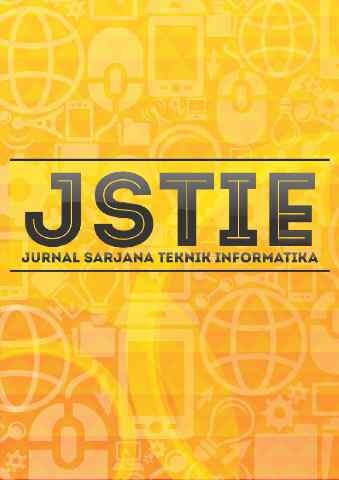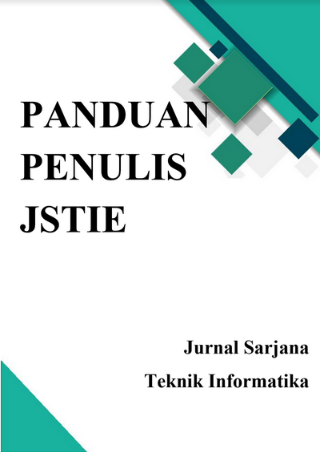Pengenalan Rumah Adat Indonesia Menggunakan Teknologi Markerless Augmented Reality
DOI:
https://doi.org/10.12928/jstie.v10i2.21811Abstract
Saat ini untuk belajar mengenai rumah adat Indonesia ketika belajar di sekolah, hanya dipelajari dari buku kebudayaan Indonesia, dimana hanya terdapat gambar dan beberapa penjelasan tanpa diketahui makna dari bentuk bangunannya. Dari hasil survey dapat diketahui bahwa 35,7% pelajar SMP sederajat tidak mengetahui, 30.6% mungkin mengetahui dan 33.7% yang mengetahui makna dari bangunan rumah adat yang diajarkan. Tujuan dari penelitian ini adalah mengembangkan media edukasi dengan mengimplementasikan teknologi Markerless Augmented Reality tentang Rumah Adat Indonesia. Pengembangan media edukasi ini menggunakan Teknologi Markerless Based Tracker Surface Tracking yang merupakan salah satu jenis metode Augmented Reality. Dengan menggunakan metode ini siswa tidak memerlukan penanda khusus dan dapat mempermudah siswa karena hanya cukup mengandalkan device saja untuk memunculkan obyek 3D. Pengumpulan data kebutuhan system dilakukan dengan cara obesvasi dan wawancara kepada siswa. Software untuk membuat aplikasi ini menggunakan Audancity, Sketchup dan Unity. Pengujian aplikasi menggunakan pengujian black box dan pengujian Sistem Usaility Scale. Pengujian dilakukan menggunakan metode Black box test dengan hasil persentase sebagai berikut: 94,12% untuk pengujian fungsionalitas system, 88,89% untuk pengujian kemiripan obyek 3d bangunan, 80% untuk pengujian kualitas audio deskripsi dan, Pengujian SUS dengan hasil sebesar 76.31%. Dengan demikian, dapat disimpulkan bahwa aplikasi yang dikembangkan layak digunakanReferences
A. Sirumapea, S. Ramdhan, and D. Rismana, “Aplikasi Pembelajaran Mengenal Rumah Adat di Pulau Jawa Berbasis Android dengan Teknologi Augmented Reality,” J. SISFOTEK Glob., vol. 11, no. 1, p. 15, Mar. 2021, doi: 10.38101/sisfotek.v11i1.339.
S. Nuraisyah, S. Sumardi, R. Giyartini, and M. R. W. Muharram, “Augmented Reality Flashcard Prototype Design as an Instructional Medium for Introducing West Java Traditional Houses in Elementary School,” Indones. J. Prim. Educ., vol. 5, no. 1, pp. 113–124, Jun. 2021, doi: 10.17509/ijpe.v5i1.36980.
A. Hafiz, “Pengembangan Aplikasi Pengenalan Rumah Adat Sumatera Berbasis Augmented Reality,” J. Teknol. dan Inform., vol. 1, no. 1, pp. 1–6, 2020.
G. E. Saputra, “Analisa dan Perancangan Markerless Augmented Reality Application Rumah Adat Minangkabau dengan Menggunakan Metode Prototyping Berbasis Android,” J. Ilm. Komput. Sist. Inf., vol. 19, no. 3, pp. 443–454, 2020.
N. K. Sutiari, I. K. G. D. Putra, and M. S. Raharja, “Aplikasi Pengenalan Rumah Adat Indonesia Berbasis Augmented Reality,” J. Ilm. Merpati (Menara Penelit. Akad. Teknol. Informasi), vol. 6, no. 2, pp. 108–118, 2018.
Z. S. Azkya, I. Ardiansah, and T. Pujianto, “Analisis User Experience pada Warehouse Marketplace dengan Metode Heuristic Evaluation,” J. Tek. Inform. dan Sist. Inf., vol. 6, no. 1, Apr. 2020, doi: 10.28932/jutisi.v6i1.2378.
S. Syamsiah, “Perancangan Flowchart dan Pseudocode Pembelajaran Mengenal Angka dengan Animasi untuk Anak PAUD Rambutan,” STRING (Satuan Tulisan Ris. dan Inov. Teknol., vol. 4, no. 1, p. 86, Aug. 2019, doi: 10.30998/string.v4i1.3623.
H. Ajie, M. Zulfikar, and V. Oktaviani, “Penerapan Konsep User Experience (UX) Pada Perancangan Dashboard Profil Mahasiswa Baru Universitas Negeri Jakarta,” PINTER J. Pendidik. Tek. Inform. dan Komput., vol. 3, no. 2, pp. 88–97, Dec. 2019, doi: 10.21009/pinter.3.2.2.
D. Yulianto, R. Hartanto, and P. I. Santosa, “An Interactive Book With Augmented Reality For Learning The Cirebon Mask Dance,” J. Infotel Informatics, Telecommun. Electron., vol. 10, no. 3, 2018, doi: 10.20895/infotel.v10i3.374.
D. Yulianto, R. Hartanto, and P. I. Santosa, “Evaluation on Augmented-Reality-Based Interactive Book Using System Usability Scale and User Experience Questionnaire,” J. RESTI (Rekayasa Sist. dan Teknol. Informasi), vol. 4, no. 3, pp. 482–488, Jun. 2020, doi: 10.29207/resti.v4i3.1870.
Downloads
Published
Issue
Section
License
License and Copyright Agreement
In submitting the manuscript to the journal, the authors certify that:
- They are authorized by their co-authors to enter into these arrangements.
- The work described has not been formally published before, except in the form of an abstract or as part of a published lecture, review, thesis, or overlay journal. Please also carefully read Journal Posting Your Article Policy.
- The work is not under consideration for publication elsewhere.
- The work has been approved by all the author(s) and by the responsible authorities – tacitly or explicitly – of the institutes where the work has been carried out.
- They secure the right to reproduce any material that has already been published or copyrighted elsewhere.
- They agree to the following license and copyright agreement.
Copyright
Authors who publish with Jurnal Sarjana Teknik Informatika agree to the following terms:
- Authors retain copyright and grant the journal right of first publication with the work simultaneously licensed under a Creative Commons Attribution License (CC BY-SA 4.0) that allows others to share the work with an acknowledgement of the work's authorship and initial publication in this journal.
- Authors are able to enter into separate, additional contractual arrangements for the non-exclusive distribution of the journal's published version of the work (e.g., post it to an institutional repository or publish it in a book), with an acknowledgement of its initial publication in this journal.
- Authors are permitted and encouraged to post their work online (e.g., in institutional repositories or on their website) prior to and during the submission process, as it can lead to productive exchanges, as well as earlier and greater citation of published work.








